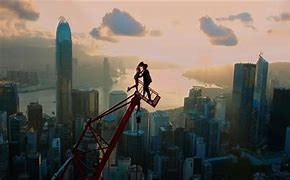Manhattan, July 19: It started out as a film about rooftoppers.
The risk-takers who pose atop the world’s tallest buildings, without safety nets or permission, had long been a fascination for filmmaker Jeff Zimbalist. He’d dabbled in the activity, on a smaller scale in his youth, and was fascinated to learn that it had become a global phenomenon on social media.
One rooftopper who stuck out was Angela Nikolau, notable for being one of the few women operating in the space. She introduced him to Ivan Beerkus, a fellow rooftopper who she’d begun doing joint posts with. Together, they were fascinating and good on camera.
“We didn’t know what the finish line was,” Zimbalist said in a recent interview with The Associated Press. “We really took a leap of faith on this.”
But in the making of “ Skywalkers: A Love Story,” now streaming on Netflix, Zimbalist quickly realized that there was something bigger happening with his subjects: They were falling in love.
This, he knew, was the story. The vertigo-inducing spectacle was the backdrop.
And like illegally climbing an under-construction skyscraper, nothing was going to be simple or straightforward about the mission of putting it all together. In total, the small team spent six years making the film, traveling to six countries with Nikolau and Beerkus to capture their attempts to pose on top of the likes of the 1,957-foot (596.6-meter) Goldin Finance 117, in Tianjin, China, and the 2,227-foot (679-meter) Merdeka 118 in Kuala Lumpur, Malaysia.
The film begins in a tense moment in Merdeka: They’re trying to get to the top undetected. They’re scared. And their relationship is on the line.
Behind the scenes was the inherent danger of it all: The trespassing aspect takes on a different kind of gravity in strict countries like Malaysia. Add in the difficulties of continuing production through COVID and Russia’s war on Ukraine, the logistics of filming without distracting, and the constant conversation about trust — not only between filmmaker and subjects but between the subjects themselves.
“They’d only been doing short form,” Zimbalist said. “The idea that we wanted access to all of the stuff in between their perfect, polished, finished poses was a new concept to them.”
Nikolau was already relatively famous by the time Zimbalist got in touch. Born in Moscow to circus performer parents, she began amassing a large social media following by posting photos of herself on the top of buildings in acrobatic poses. Beerkus was too, for his more “extreme” photographs and films. They were both ardently solo acts. But when they started climbing and posing together, around the time when Zimbalist and his team began to follow them, their popularity grew. Prior to the Netflix debut, she had over 730,000 followers on Instagram, and he had over 236,000.
“We wanted to give it all to this project like we always do,” Beerkus said through Maria Bukhonina, who co-directed the film and translated their interview. “But it was unusual when the cameras started following us everywhere.”




